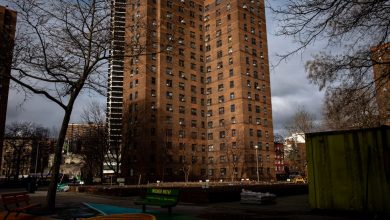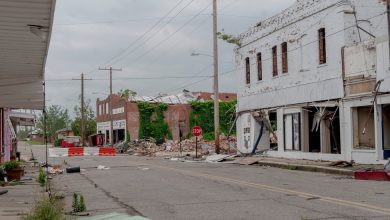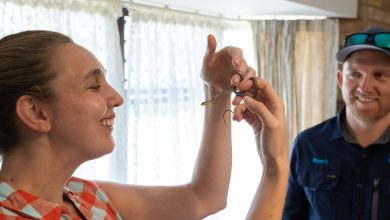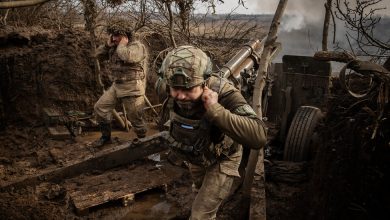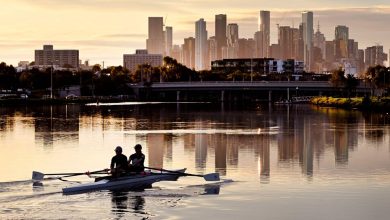School Year Resumes in Ukraine, but Bleak Season of War Upends Classes

BUCHA, Ukraine — The bodies that littered the school playground in April are gone. The blood on the walls has been scrubbed clean and shattered windows mostly repaired.
Still, School No. 3 in the Kyiv suburb of Bucha, the site of some of the worst Russian atrocities of the war, did not open when classes began on Thursday for millions of Ukrainian children. The reason for the delay: All schools are now required to have bomb shelters, and School No. 3’s basement, which residents say was once used as a torture chamber by Russian soldiers, is still an off-limits crime scene.
For 6-year-old Vera, who says she loves math and castles, that means remote learning. She had looked forward to the first day of school, when, according to tradition, first graders are hoisted on the shoulders of older students to ring a bell to usher in the school year and kick off a day of celebrations.
Instead, the day before school was to begin, she sat at a solitary desk outside her school in Bucha, posing with a bell in hand. She smiled, but only briefly, and her mother, Lyudmila, said she was upset to not be in a classroom despite the school’s attempts to make the day festive with singing and a small ceremony.
“It is a bleak and unwelcome experiment in childhood suffering,” James Elder, spokesman for UNICEF, the U.N. Children’s Fund, said in an interview.
With sandbags outnumbering backpacks, class sizes limited by how many children can cram into bomb shelters, and schools being supplied with first-aid kits, the day was not so much an end of summer recess but a continuation of the bleak season of war. Thousands of schools have been damaged by Russian bombs and rockets, hundreds completely destroyed and for millions of children a day normally filled with excitement and anxiety started with a lesson in what to do when the air raid alarm wails.
And that is for the children who can return to classes at all. With thousands of schools damaged or destroyed, Mr. Elder said, less than 60 percent are expected to open on time.
An estimated 2.8 million of the nation’s six million children have been forced from their homes because of the war. If they are fortunate enough to find a seat in a classroom, it will probably be in an unfamiliar town or city. An additional two million children are estimated to be living outside Ukraine and will either log on remotely for schooling with Ukrainian teachers or try to integrate into new schools with classes taught in foreign tongues.
The State of the War
- A New Counteroffensive: Ukraine has long vowed a major push in the southern region of Kherson to retake territory seized by Russia. It may have begun.
- Nuclear Plant Standoff: After renewed shelling intensified fears about a nuclear accident at the Zaporizhzhia power plant, United Nations inspectors reached the Russian-controlled station for a high-stakes visit.
- Russia’s Military Expansion: Though President Vladimir V. Putin ordered a sharp increase in the size of Russia’s armed forces, he seems reluctant to declare a draft. Here is why.
- Unusual Approaches: Ukrainian troops, facing strained supply lines, are turning to jury-rigged weapons and equipment bartering among units.
And then there are the hundreds of thousands of Ukrainian children living under Russian occupation in the east and south of Ukraine, where Moscow is trying to impose the new Russian curriculum and teachers who refuse to cooperate face harsh reprisals, including kidnapping and torture, according to Ukrainian officials.
Over the past week, an average of 500 families have been recorded leaving occupied territories in the southern regions of Ukraine each day, according to the National Resistance Center, a government agency supporting resistance efforts in occupied areas. One of the main reasons given, the agency said, was the approaching school year, with parents desperate to shield their children from Russian propaganda in the new curriculum.
Maksim, 30, is a teacher who said that he had escaped from the occupied southern city of Kherson this week after refusing to teach the new curriculum and who like others interviewed wanted only their first names used for fear that they or their families in occupied territory would face reprisals.
“The director of the school tried to force me to stay,” he said after crossing into Ukrainian government-controlled territory. “The Russians are not letting any teachers leave. If they knew I was a teacher at the checkpoints, they would never have let me through.”
Even as the Russian military confronts an intensifying counteroffensive and ammunition depots in occupied territories are hit nightly by Ukrainian forces, Moscow remains engaged in a concentrated effort to Russify the population in areas under its control.
The schools are a central part of that campaign.
The Russian education minister, Sergei Kravtsov, said in late June that the Ukrainian education system “must be corrected.” According to Moscow, that means teaching a version of history that aligns with the false Kremlin narrative that there is no such thing as Ukrainian nationhood.
Yuri Sobolevsky, the exiled deputy head of the Kherson regional administration, said that Russian forces were terrorizing schools and had recently kidnapped a local principal who refused to teach the Kremlin’s curriculum.
“There is a tremendous pressure on all school principals throughout the region,” Mr. Sobolevsky said.
International rights groups and independent journalists are largely barred from occupied territories, making verification of the accounts of witnesses and officials all but impossible.
Andriy was born in Zolote, a small town in the Luhansk region that numbered about 13,000 before the war. He became a teacher at the same school he attended as a child.
By late June, he said, Russians had destroyed 95 percent of the town and most people had fled. Only one girl was left, a 5-year-old. The school is one of the few buildings standing but there are no teachers, so there are no classes for her, Andriy said.
Andriy, who stayed in Zolote to take care of his mother, is working in another school in another town, also occupied by Russian forces. Fortunately, he said, he teaches math, which is not affected by the new curriculum.
“Math is the same and children are the same everywhere, so I will be continuing my work,” he said. But classes in the Luhansk region will be online because of the heavy shelling that still rocks the area.
The challenges in parts of Ukraine still controlled by the government in Kyiv are also daunting.
Teachers are receiving training in how to treat battlefield wounds and what to do in case they come across unexploded ordnance.
UNICEF said that it had reached around 1.7 million children and their caregivers, offering psychological and other support.
“From Yemen to Syria, what we have learned is that children just absolutely need this psychological break from war,” Mr. Elder said. “And attending class plays a critical role in that.”
The fact that schools are opening at all in Bucha and in other hard-hit towns and cities across Ukraine is in many ways remarkable.
Anatolii Fedoruk, the mayor of Bucha, said that in the first days of the war, many families sought shelter in schools, thinking of them as places of refuge.
“They were wrong; they were not safe,” he said. During 32 days of Russian occupation, he noted, schools were turned into firing positions and places of oppression.
He spoke outside School No. 5, where a tank had taken position in the schoolyard, the blackened walls of a high-rise apartment building across the street testimony to the violence.
Mr. Fedoruk credited the nonprofit Global Empowerment Mission, a disaster-relief nonprofit, with providing the much-needed assistance to get the town’s 15 schools rebuilt so that most could open on Sept. 1.
“One of the most difficult questions for parents considering returning is whether their children can go to school in a safe environment,” he said. “This is not a full postwar rebuild, this is about getting kids in classes and parents back home.”
But many families have nowhere to return. Whole towns and cities in eastern Ukraine have been essentially razed and many of those families fled west early in the war.
That is placing a burden on cities like Lviv in western Ukraine.
“While every effort is being made to accommodate the needs of kids and their families in Lviv and surroundings, it is overwhelming,” said Dr. Irwin Redlener, co-founder of the Ukraine Children’s Action Project, a nonprofit group. And many Ukrainian children have special needs given the trauma that they have witnessed.
“There are two looming issues that can undermine the future of Ukraine’s children and the country itself: long-term educational disruption; and persistent, unmanaged psychological trauma,” he said.
Lyudmila says that she has tried to explain what is happening to Vera, her daughter, though she only offers a “light” version.
Her daughter knows that Russian soldiers broke into their home when they fled. But her mother keeps hidden the details of the horrors that unfolded at her school, which has children from first grade to 12th grade and which Lyudmila also attended when she was a child.
Vera should have “nice memories” of the school, as she once did, Lyudmila said.
